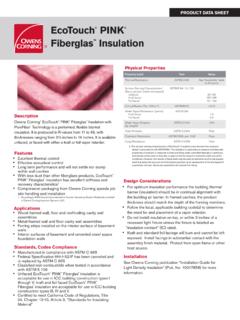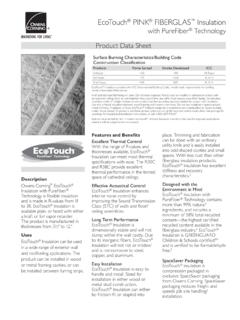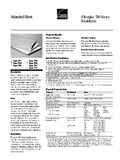Transcription of MATERIAL SAFETY DATA SHEET – UMI - upf-usa.com
1 Web Site: Customer Service: 3747 Standard Street Bakersfield, California 93308 (661) 323-8227 Fax: (661) 324- 2635 MATERIAL SAFETY data SHEET UMI SECTION 1: PRODUCT IDENTIFICATION CAS Number: Mixture / None Assigned Product Name: UPF Ultracore Marine Insulation Generic Name: Fiber Glass Wool Product Chemical Name: Mixture Formulation: Mixture Manufacturer: UPF Corporation Address: 3747 Standard Street Bakersfield, CA 93308 Telephone: (661) 323-8227 Emergency: (661) 323-8227 Fax: (661) 324-2635 Trade Name: Ultracore Marine Insulation (1075, 1100) SECTION 2: INGREDIENTS INGREDIENT NAME CAS NUMBER PERCENT EXPOSURE LIMITS Fiber Glass Wool 65997-17-3 65 to 95 1 fiber/cc TWA (ACGIH) 5 mg/m3 TWA respirable fraction (OSHA) 15 mg/m3 total dust (OSHA) Urea extended Phenol-Formaldehyde Resin (cured) 25104-55-6 05 to 35 Not established Urea extended Melamine Resin (cured) 25212-25-3 00 to 04 Not established Silicone emulsion N/A (Mixture) 00 to 08 Not established Fiberglas Cloth Facing N/A (Mixture) 00 to 80 Not established SECTION 3: HAZARD IDENTIFICATION EMERGENCY OVERVIEW Fibrous glass MATERIAL with or without fiberglass cloth facing having no significant odor Under normal conditions of use this product is not expected to create any unusual emergency hazards.
2 Inhalation of excessive amounts of dust from the product may cause temporary upper respiratory irritation and/or congestion. Remove affected individuals to fresh air. Skin irritation may be treated by gently washing affected area with soap and warm water. Eye irritation may be treated by flushing eyes with large amounts of water. If irritation persists, contact physician. In the event of fire, use normal firefighting procedures to prevent inhalation of smoke and gas. POTENTIAL HEALTH EFFECTS SUMMARY Breathing dust from this product may cause a scratchy throat, congestion and slight coughing. Getting dust or fibers on the skin or in the eyes may cause itching, rash or redness. ACUTE (SHORT TERM) HEALTH EFFECTS Dust from this product is a mechanical irritant that means that it may cause irritation or scratchiness of the throat and/or itching of the eyes and skin. 1 Web Site: Customer Service: 3747 Standard Street Bakersfield, California 93308 (661) 323-8227 Fax: (661) 324- 2635 MATERIAL SAFETY data SHEET UMI CHRONIC (LONG TERM) EFFECTS See Section 11 of this MSDS.
3 TARGET ORGANS Throat, lungs, skin and eyes. PRIMARY ROUTES OF ENTRY (EXPOSURE) Inhalation (breathing dust or fiber) and skin and eye contact. MEDICAL CONDITIONS THAT MAY BE AGGRAVATED Pre-existing chronic respiratory, skin or eye disease or condition. SYMPTOMS OF OVEREXPOSURE INHALATION Irritation of upper respiratory tract (scratchy throat), coughing and congestion may occur in extreme exposure. SKIN Temporary irritation (itching) or redness may occur. ABSORPTION Not applicable. INGESTION This product is not intended to be ingested or eaten under normal conditions of use. If ingested, it may cause temporary irritation to the gastrointestinal (GI) tract, especially the stomach. EYE Temporary irritation (itching) or redness may occur. SECTION 4: FIRST AID MEASURES INHALATION Remove to fresh air. Drink water to clear throat. Blow nose to remove dust and fibers.
4 SKIN Wash gently with soap and warm water to remove MATERIAL . Wash hands before eating or using the restroom. ABSORPTION Not applicable. INGESTION Product is not intended to be ingested or eaten. If this product is ingested, irritation of the gastrointestinal (GI) tract may occur and should be treated symptomatically. Rinse mouth with water to remove fibers and drink plenty of water to help reduce the irritation. No chronic effects are expected following ingestion. EYE Do not rub or scratch eyes. Dust particles may cause the eyes to be scratched. Flush eyes with large amounts of water for 5 15 minutes. If irritation persists, contact physician. NOTE TO PHYSICIAN This product is a mechanical irritant and is not expected to produce chronic health effects from acute exposure. Treatment should be directed toward removing the source of irritation with symptomatic treatment if necessary. 2 Web Site: Customer Service: 3747 Standard Street Bakersfield, California 93308 (661) 323-8227 Fax: (661) 324- 2635 MATERIAL SAFETY data SHEET UMI SECTION 5: FIRE FIGHTING MEASURES SUMMARY No special procedures are expected to be necessary for this product.
5 Normal firefighting procedures should be followed to avoid inhalation of smoke and glass. UNUSUAL FIRE / EXPLOSION HAZARDS There is no potential for fire or explosion. EXTINGUISHING MEDIA Carbon dioxide (CO2), water, water fog, dry chemical. FLAMMABILITY PROPERTIES Flash Point: Not applicable FP Test Method: Not applicable Flammability Limits: Not applicable Flame Classification: Not determined Flame Propagation: Not determined Auto-ignition Temperature: Not determined Decomposition Temperature: Not determined EXPLOSIVE LIMITS Lower Explosive Limit: Not applicable Upper Explosive Limit: Not applicable SECTION 6: ACCIDENTAL SPILL / RELEASE MEASURES CONTAINMENT PROCEDURES Pick up large pieces. Vacuum dust. If sweeping is necessary, use a dust suppressant such as water. Do not dry sweep dust accumulation. These procedures will help to minimize potential exposures. DISPOSAL Wastes are not hazardous as defined by the Resource Conservation and Recovery Act (RCRA; 40 CFR 261).
6 Comply with state and local regulations for disposal of fiberglass wool products. If unsure of regulations, contact local Public Health Department or the local offices of the Environmental Protection Agency (EPA). SECTION 7: HANDLING AND STORAGE STORAGE / HANDLING Use protective equipment as described in SECTION 8 of this MSDS when handling uncontained MATERIAL . Warehouse storage should be in accordance with any package directions. MATERIAL should be kept dry and protected from the elements. 3 Web Site: Customer Service: 3747 Standard Street Bakersfield, California 93308 (661) 323-8227 Fax: (661) 324- 2635 MATERIAL SAFETY data SHEET UMI SECTION 8: EXPOSURE CONTROL / PERSONAL PROTECTION SUMMARY Protective equipment should be provided as necessary to prevent irritation of the throat, eyes and skin and to keep exposure below the applicable exposure limits identified in SECTION 2 of this MSDS.
7 EYE SAFETY glasses with side shields are recommended to keep dust and fibers out of the eyes. SKIN Leather or cotton gloves should be worn to prevent skin contact and irritation. Barrier creams may also be used to reduce skin contact and irritation caused by fiberglass. RESPIRATORY A respirator should be used if ventilation is unavailable or is inadequate for keeping dust and fiber levels below the applicable exposure limits. In those cases, use NIOSH certified disposable or reusable particulate respirator with efficiency rating of N95 or higher (under 42 CFR 84) when working with this product. For exposures up to five times the established exposure limits use a quarter mask respirator rated N95 or higher. For exposures up to ten times the established exposure limits use a half mask respirator ( MSA DM-11, Racal Delta N95, 3M 8210) rated N95 or higher. Operations such as sawing, blowing, tear out and spraying may generate airborne fiber concentrations requiring higher level of respiratory protection.
8 For exposures up to 50 times the established exposure limits use a full-face respirator rated N99 or higher. VENTILATION Local exhaust ventilation should be provided at areas of cutting to remove airborne fibers. General dilution ventilation should be provided as necessary to keep airborne dust and fibers below the applicable exposure limits and guidelines. The need for ventilation systems should be evaluated by a professional industrial hygienist. The Design of specific ventilation systems should be conducted by a professional engineer. OTHER Loose fitting, long sleeve clothing should be worn to protect skin from irritation. Exposed skin areas should be washed with soap and warm water after handling or working with fiberglass. Clothing should be washed separately from other clothes. The washer should be rinsed thoroughly (run empty for a complete wash cycle). This will reduce the chance of fiberglass being transferred to other clothing. SPECIAL CONSIDERATION FOR REPAIR / MAINTENANCE OF CONTAMINATED EQUIPMENT Use personal protective equipment as discussed above.
9 Where possible, use a vacuum cleaner before repair / maintenance to remove excessive dust and loose fiber. SECTION 9: PHYSICAL AND CHEMICAL PROPERTIES PROPERTIES Boiling Point: Not determined Evaporation Rate (Butyl acetate = 1): Not determined Melting Point: >704 oC / 1300oF pH: Not applicable 4 Web Site: Customer Service: 3747 Standard Street Bakersfield, California 93308 (661) 323-8227 Fax: (661) 324- 2635 MATERIAL SAFETY data SHEET UMI Saturation in Air (%): Not applicable Solids Content: Not applicable Specific Gravity (Water = 1): Not applicable Vapor Density (Air = 1): Not applicable Vapor Pressure: Not applicable VOCs (g/liter): Not applicable Volatile by Volume (%): 0 Water Solubility (%): Nil APPEARANCE AND ODOR Fibrous glass blanket of various colors with or without non-woven facing. No significant odor. SECTION 10: STABILITY AND REACTIVITY STABILITY Product is stable.
10 Hazardous polymerization will not occur. REACTIVITY This product is not reactive. HAZARDOUS DECOMPOSITION PRODUCTS Decomposition products are those expected from any organic MATERIAL and are mainly derived from pyrolysis or burning of the resin. SECTION 11: TOXICOLOGICAL AND EPIDEMIOLOGICAL data ACUTE EFFECTS The fibers from this product are mechanical irritants and may cause transitory irritation to exposed areas such as eyes, skin and upper respiratory passages. CHRONIC EFFECTS IRAC reclassified fiberglass wool as Group 3 (not classifiable as to its carcinogenicity to humans) based on current human and animal research that shows no association between inhalation exposure and development of respiratory disease. ACGIH (A3 Confirmed animal carcinogen with unknown relevance to humans) and NTP (Reasonably anticipated to be a carcinogen respirable size) have not reviewed the IRAC reclassification of fiberglass wool and continue to base their classifications on earlier animal studies.




